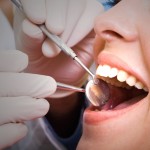
In the UK the majority of adult patients who attend for routine check ups do not require any further addition treatment. However, it is dentists, the most expensive resource who undertake check ups. The use of mid-level providers like hygiene-therapists (H-Ts) would free up resources.
The aim of this study was to assess whether H-Ts could be used in a screening role in dental practice.
Methods
Study design was based on a diagnostic test accuracy (DTA) methodology. Dental practices with at least on H-T and a large throughput of NHS patients were recruited. Dentists and H-Ts attended a compulsory training day with calibration being conducted using stock photographs. Dentist training was considered successful when values for sensitivity exceeded 85%; specificity 65%.
Diagnostic thresholds
- Caries: – any tooth in the patient’s mouth that showed evidence of frank cavitation or shadowing and opacity that would indicate dental caries into the dentine (when clean and dried).
- Periodontal: – any pocket in the patient’s mouth where the black-band of a basic periodontal examination (BPE) probe (3.5 to 5.5 mm) partially or totally disappeared.
Asymptomatic adults patients (≥18yrs) attending for routine inspections were invited to participate. Consenting patients were screened for caries and periodontal disease by the H-Ts (Index test) and dentists (Reference [gold] standard).
Results
- 1899 patients consented to dental screening
- 996 patients were randomly allocated to see the GDP first, and 903 attended the H-T first.
- The interval between Index and Reference test never exceeded 21 minutes.
- There were no missing results regarding the outcome of a positive or negative screening decision. However, 2 practices failed to collect data on smoking and dentures.
- There were no adverse events.
- Mean screening time was 5 min 25 s for H-Ts and 4 min 26 s for dentists.
- Dentists identified 668 patients with caries (Prevalence of 0.35) while H-Ts classified 548 positive and correctly identified 1,047 of the 1,231 patients with no caries.
- Dentists identified 1074 patients with at least one pocket exceeding 3.5 mm in depth. Of these 935 were correctly identified by the H-Ts. For the 825 screened as negative by the dentist H-Ts correctly identified 621.
- The summary sensitivity points H-Ts are shown in the table below.
| SensitivitySummary point (95% CI) | SpecificitySummary point (95% CI) | |
| Caries | 0.81 (0.74 to 0.87) | 0.87 (0.78 to 0.92) |
| Periodontal Disease | 0.89 (0.86 to 0.92) | 0.75 (0.66 to 0.82) |
Conclusions
The authors concluded
The results suggest that hygiene-therapists could be used to screen for dental caries and periodontal disease. This has important ramifications for service design in public- funded health systems.
Commentary
This is a well-conducted study, the key weakness being the use of the dentist as a reference standard and the pros and cons of this are discussed in detail but the authors. However, the study does demonstrate that H-Ts are able to screen for both caries and periodontal disease. Whether this will lead to changes in the traditional delivery of dental care within the UK and role delegation remains to be seen.
Links
Macey R, Glenny A, Walsh T, Tickle M, Worthington H, Ashley J, Brocklehurst P. The Efficacy of Screening for Common Dental Diseases by Hygiene-Therapists: A Diagnostic Test Accuracy Study. J Dent Res. 2015 Jan 20. pii: 0022034514567335. [Epub ahead of print] PubMed PMID: 25604256.

Hygiene-Therapists! What do you think of this new diagnostic study about #screening for common dental diseases? http://t.co/Jyhesejl6K
Don’t miss – Dental screening: a role for hygiene-therapists? http://t.co/Jyhesejl6K
@TheDentalElf Interesting. Thought the H-Ts should probably be used as gold std for perio screening: more experience and accuracy?
@TheDentalElf …would have been interesting to swap roles completely.
Hi. As a Danish RDH/DTP, it`s my job to do the screening for PA, caries, bite-functional deviations, TMJ and so on. If I find it reasonable to call the dentist, I doo or I refer. It`s common in DK and I wish for my fellows in other countries, that you could be used just as much for this. It gives a much better flow at the clinic and a much better understanding and cooperation between dentist and RDH.
[…] Feb 2015 – Dental screening: a role for hygiene-therapists? […]